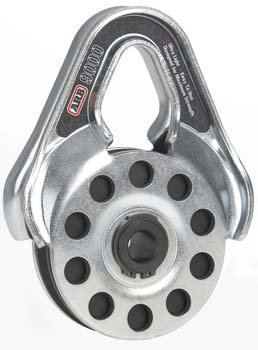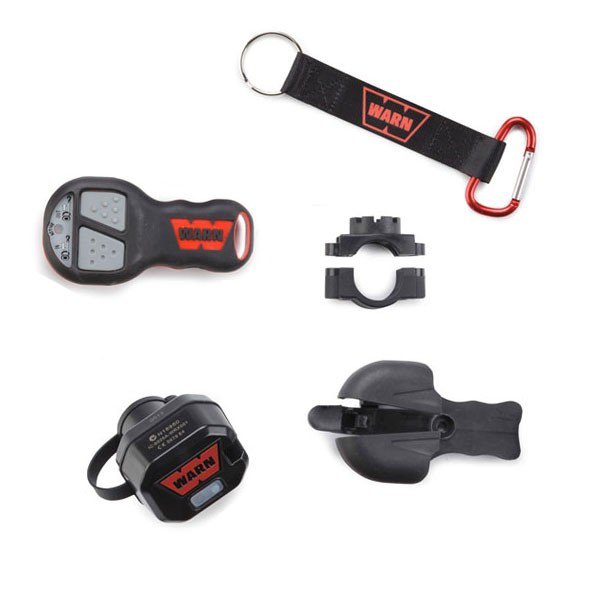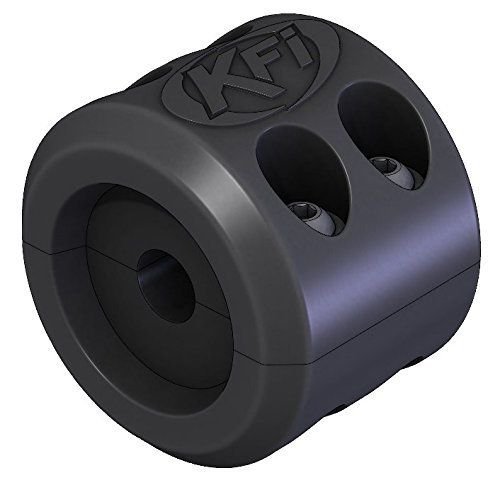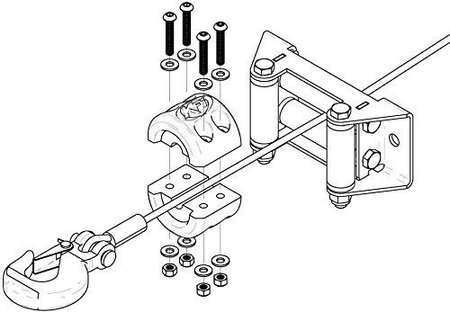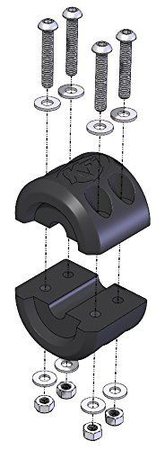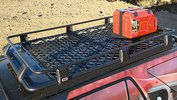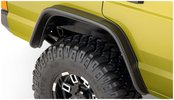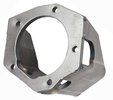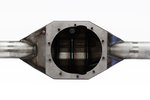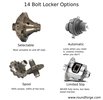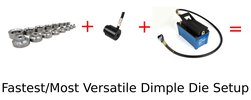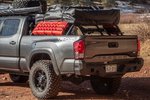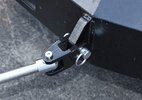The Best Winch Accessories For Off Roading

A few accessories will make winching easier and safer, and allow you to do more things with your winch.
- The Winch Recovery Kit Comparison Guide
- The Best Hi Lift Jack Accessories
- It’s extremely dangerous and damages your winch cable.
- You can kill or damage a tree that is your winch point.
- A winch line that’s hooked back on itself is weak at the point where
the hook latches onto the cable. If your cable snaps it can easily kill
anyone around your 4x4.
- A winch line that is wrapped around a rock is
dangerous because the rock can abrade the winch line and also kink or
damage it from running over ridges in the rock.
- A winch line wrapped around a tree will dig into it, crushing and cutting the outer and inner bark layers. This kills the tree since a tree’s nutrient transport system is in these inner bark layers. If it’s a frequently used trail, that means that eventually that tree won’t be able to be used for winching anymore.
- The cover comes with a bottle UV protectant spray. Make sure you reapply it frequently!
- Tree save strap
- Recovery strap
- 4 shackles
- Snatch block
- Winch extension strap
- Use a little dielectric grease on the plug to keep the pins and sockets from corroding.
- Make sure to use the provided leash to secure the transmitter to your winch. It’s there so that you won’t lose the transmitter if it pops out.
- There is a slight delay between pressing a button and having the winch move, unlike the instantaneous action on a wired remote. This may take a little getting used to, but the tradeoffs are worth it.
- Easily installs without removing your hook or cutting your winch line.
- Keeps your winch cable properly tensioned.
- Keeps your winch cable straight.
- Prevents your winch hook from damaging your fairlead and winch cable.
- There are 4 included metric nuts and bolts. The bolts take a 4mm Allen wrench and the nuts are 10mm.
- Be aware of the diameter of line you buy. Many winches in the 8000 lbs. range use 5/16” steel cable, but many line kits use 3/8” rope. This gives you an added margin of safety and strength, but it’ll be a little bulkier on your winch drum. Spydura comes in 80 and 100 foot lengths. The shorter length will be easier to reel on your drum without bunching, but the longer line gives that 20’ extra you might need.
- Warn says you must use a polished aluminum hawse fairlead
with Spydura, and this is debated with other winch lines. With some
caveats we think synthetic is fine with a roller fairlead. First, the
fairlead needs to be as smooth as possible. Steel cable may have marred
the rollers and this will mess up your rope. Second, the rollers need to
be adequately overlapping to keep your rope from drifting between them
and jamming. This should not be an issue with roller fairleads from most
big brands. Third, the rollers need to spin freely. All that said, your
warranty will be void if you use Spydura with a roller fairlead.
- Make sure your other gear will work with synthetic line. Fairleads, thimbles, and snatch blocks need to be smooth and be without places for rope to jam itself.
When you buy a winch, you're just getting started: you still need to buy gear to make your winch work with your 4x4. Some stuff comes in off road recovery kits. But there are a few things that don't come in a kit, but make things easier, like a receiver hitch shackle mount, or synthetic winch line. We’re going to break down some of these items and talk about the pros and cons of a few different winching accessories. By the end you should have a good idea of a few items that you need to round out your winch kit.
Vault 3/4” Shackles - 4.75 ton - DON'T LEAVE HOME WITHOUT 'EM
You should always have a few shackles so that you can attach straps, winch lines, extender straps, and snatch blocks to your 4x4 and each other.
Shackles are in our top three list of important winch accessories - you can't do recovery without them. Vault shackles attach tow straps, snatch straps, winch line, tree savers, snatch blocks, your 4x4, and other shackles together. Like a tree strap, they are an essential part of your winch’s accessory kit. Why do you need shackles? They provide a secure way to attach recovery components together safely and securely. A common use is in connecting the two ends of a tree saver strap with the shackle and then connecting the winch hook to your shackle. Some winch hooks don’t have a large enough throat to take the ends of the strap, and sometimes the strap can load the gate, which, at best, will deform it.
Another use is with a snatch block. You use your snatch block to multiply your pulling power or winch at an angle. The snatch block will be mounted on a tree with a tree saver. To connect the snatch block and tree saver, you need a shackle. In this setup, where the winch line runs out and back to your rig, you also need to connect it to your rig. This, again, is often done with a shackle.
This is how your D-ring shackle attaches to a strap or cable.
Sometimes shackles get a little stiff. Carry a screwdriver to stick in the hole that's in the screw and you'll be able to easily turn it.
Nowadays shackles are pretty cheap. We like that this pair of 3/4” shackles from Vault is powdercoated black so they won’t rust for a long time. They are drop-forged steel and have a 9,500 lb. capacity, pretty standard. The pin diameter is 7/8”. It’s worth noting that most shackles are pretty much the same in the same weight class as long as you go with a reputable manufacturer. Any fourwheeler should have at least two shackles; we usually carry at least four. Even if you don’t have a winch, they are useful for hooking straps to your rig.
ARB 26,500 lb Tree Saver Strap - BE SAFE AND RESPONSIBLE
You need a tree saver strap. It protects the trees that you use as winch anchors to keep our backcountry areas beautiful!
The second winch accessory that everyone needs is a tree saver strap. When you winch, you need to attach your winch cable to something other than itself. You can’t loop your winch cable around the winch point for 2 reasons:
Not using a tree strap is considered to be very bad manners when you're on the trail because of the damage you do to the trail and may do to others if your unprotected winch line breaks. A tree saver strap prevents these kinds of situations:
The ARB Tree Saver Strap is a padded strap that you can wrap around a tree or rock for safe winching that won’t destroy your winch point. It comes in 10’ (3m) and 16’ (5m) lengths and is 3” (80mm) wide. It’s made of non-stretching polyester and has reinforced eyes. Unlike many other tree saver straps, it has eye and seam protective sleeves. These are great for two reasons: they provide general abrasion protection, and they also keep the main strap cleaner. Small dirt particles that get in your strap can abrade it and wear it out more quickly.
Tree saver straps also protect your winch cable. Some winch users hook the cable onto the winch line, but this can kink and damage it. Never hook your winch cable back on itself.
The ARB strap has a minimum breaking strength of 26,400 lbs. (12,000 kg) which is plenty for most 4x4s. A tree saver strap is good for the tree and good for your winch cable. These are not recovery straps. Recovery straps stretch; these do not. These straps are meant to be attached to a static point for winch recovery.
10 Foot Long ARB Tree Saver Strap:
16 Foot Long ARB Tree Saver Strap:
ARB Orange Recovery Damper - KEEP YOUR HEAD...
You should always have a damper on your winch line whether it's synthetic or steel. Don't listen to anyone that tells you your synthetic line doesn't need a damper.
The third winch accessory that everyone needs is a recovery damper.
Remember in Die Hard with a Vengence when a cable snaps on the boat and cuts a guy in half? Okay, so that probably wouldn't happen in real life, but...
Sometimes winch lines and straps break. Suddenly you have a dangerous
object flying through the air - the winch line or strap. They break
under high load and have massive amounts of potential energy stored
until they break. Then all that potential energy is converted into
kinetic energy that can maim or kill anyone that is close enough.
Consider also if the recovery mount on a 4x4 broke instead of the winch line. Instead of a cable flying at
you, it could be a broken tow hook. The lethality here is so profound
that recovery weights are now mandated in many 4x4 competitions. There are stories just about every year of people killed and injured when something in the recovery system breaks and there is nothing to dampen the kinetic energy of flying parts.
So how do we fix this? We throw a weight over the line that will absorb some of the kinetic energy when the winch line or strap snaps. It’s totally simple and could save someone’s life. We like the ARB Recovery Weight for this purpose. The ARB unit is made of bright orange vinyl, so it’s always easy to find, unlike some other recovery dampers. It folds in half over your winch line to a size of 17” x 20” and secures in place with velcro. It has a pocket on one side; according to ARB this is to hold shackles and snatch blocks while walking them out to your anchor, but it’s not really for long term storage. It weighs about 3 lbs
You should also be using a damper on recovery straps. They store a lot of energy and can snap just line a winch line.
This winch accessory is all about safety. Make sure you always have a weight on your cable or strap when loaded.
If you're on a budget:
You can wrap a heavy towel or blanket around your winch line or strap. Make sure it is secure enough that it won’t fall off. It's a little less convenient than a dedicated weight, but it could save the life of you or your loved ones if a strap, cable, or shackle mount breaks.
Snatch Block - DOUBLE YOUR PULLING POWER!
This snatch block lets you easily change your pull direction and increase your winch's pulling power. It's lightweight, has a 20,000 lb capacity, and can take synthetic or steel winch line.
A snatch block is not one of the most essential winch accessories, but when you have it, you’re glad it’s there. A snatch block is a big pulley rated to take a lot of weight. It makes your winching setup more flexible. Here are some ways you'd use it:
A snatch blocks doubles your pulling power
In it’s tamest use you would mount it to an anchor in front of your stuck 4x4. You run your winch line out to the snatch block, thread it through and reconnect it to a sturdy point on your 4x4. In this configuration you will double your pulling power with the mechanical advantage provided by the snatch block. This also cuts your linespeed in 1/2 and means you use twice as much winch line as you would with a simple single line pull but this can really get you out of a bad situation. Sometimes you really need that extra pulling power and this does it!
A snatch block redirects your winch line to recover buddies on the trail
Sometimes you a recovery strap won't work to pull out a stuck buddy - the strap is too short, the angle is wrong, or you don't have a good runway for a yank.
Imagine that you drive through a muddy section of trail. Your buddy, driving a rig with no winch and smaller tires, gets stuck in your ruts. You can’t do a snatch strap recovery or a straight line pull, so instead you hook up the snatch block to a tree in front of your buddy. You position yourself off to the side of the trail and run your winch cable through the snatch block and to his rig. This way you can winch him without getting back in the muddy spot and making it worse or getting stuck yourself! If necessary, you can even secure the back of your rig and position the winch cable at a more advantageous angle for more pulling power.
A snatch block redirects your winch line to do winching work
There are lots of problems that a snatch block will solve by giving you more pulling power and the ability to change your 4x4’s position.
A good snatch block has a high weight rating, accommodates different cables sizes, and has extremely narrow gaps between the pulley and side plates. You want a narrow gap to prevent cable from running off the pulley and jamming your snatch block. When buying a snatch block, pay attention to your weight requirements, winch line diameter, and whether you have synthetic or steel winch line.
We’ve got two picks for snatch blocks, one is the ARB Ultra Light 10100020. It’s rated for 20,000 lbs. and can be used with synthetic or steel winch line with a 1/4” to 1/2” diameter. It’s expensive, but it’s stronger and more versatile than our second pick. Its side plates are 6mm cold rolled steel and the pulley is polymer (plastic). It’s an extremely pretty and robust snatch block.
Our second choice is a lot more budget-friendly but has fewer features. It’s the Smittybilt 2744 Universal Snatch Block. It is also rated at 17,600 lbs. and costs less than a third of the ARB. You could literally buy three of these for the price of one ARB! It will take 7/32”-3/8” steel winch line. The pulley is steel.
This 17,600 lb. snatch block is good for up to 3/8" steel winch lines - no synthetic though.
There are some drawbacks to it - it’s load-rated lower than the ARB and it’s not recommended for use with synthetic winch lines, only steel. The pulley is not completely smooth and could damage a synthetic winch line. Some people report success with sanding the pulley to a smooth finish, but it’s better to buy the right pulley for your line.
Shackle Hitch Receiver with 3/4” Shackle by Vault - PULL EASILY FROM YOUR HITCH
This adapter slides into your 2" hitch receiver in seconds and secures with a 5/8" pin.
A hitch receiver shackle is a cheap, easy way to add another recovery point to your 4x4. It’s centered, secure if your hitch is mounted properly, and this one from Vault has a couple extra features beyond standard ones. If you’ve ever put a tow strap, snatch block, winch cable, or shackle on a hitch ball, don’t ever do it again! Hitch balls are not designed for the kind of force that recovery operations can create. Furthermore, they are mounted in single-shear and experience vastly different loading than a fixture that is mounted in double shear. Hitch balls can break off and fly through the air, killing and maiming anyone around your rig.
This receiver D-ring shackle setup from Vault is much more secure. It slides right into any 2” receiver hitch and secures with a standard 5/8” pin (not included). The included shackle is a 3/4” shackle with a 7/8” pin. It is rated for 10,000 lbs. You can pick up a locking hitch pin and leave it attached to your rig 24/7. Installation is as simple as sliding it in your hitch, and securing the hitch pin - a one minute job.
There are a lot of hitch receiver mounts like this with D-rings, but the Vault unit has two features that we really like. The first is that there are 4 mounting holes, that allow you to mount it with the shackle horizontal or vertical. This makes your pulling more versatile, since you can position the shackle more optimally for a pull. Winching or pulling from an angle with the shackle horizontal will sideload the shackle - ideally you want the pull direction to be perpendicular to the shackle’s pin. By flipping the shackle up to vertical, you can do this easily.
With a 10,000 lb. capacity rating this gives you an easy, centralized tow point on your rear bumper. This works great if your bumper doesn't have any shackle mounts.
Secondly, it has a black powdercoat finish. Most hitch receiver shackles have a zinc finish. This will wear away quickly and starting rusting. Powdercoat is a hard, durable finish that lasts a very long time. Chipping can be a problem on some powdercoated products, but Vault has done a great job with this one.
This is an easy-to-install, cheap winch accessory, and if you ever need to winch or yank using your receiver as a pull point, this is a great product to have.
Winch License Plate Mount by Cascadia - STAY LEGAL ON THE ROAD
Warn Neoprene Winch Cover
Keep your winch clean and corrosion-free. Protect your steel cover from water and your synthetic winch line from the sun!
Winches are pretty sturdy things. They are made from aluminum, steel,
and a little plastic and can weather quite a bit of abuse. You can
leave your winch out and it will probably last you plenty. But if you
really want to take care of it, you should cover it up. Keeping dust,
mud, rain, and sun off your winch is a good thing. Since your winch is likely
mounted somewhat permanently to your 4x4, and your 4x4 is outside all
the time, you’re constantly subjecting your winch to all kinds of stuff.
Without a cover, your steel cable will start to rust more quickly. Your plastic solenoid box will eventually start to discolor, and with enough time it will become brittle from the sun exposure. If you have a synthetic winch rope, you need a winch cover to protect your line so that it lasts longer and doesn’t snap when you need it most. Electrical connections and solenoid box are more vulnerable to corrosion as they are exposed to more rainwater and splash-up from the road.
A winch cover securely surrounds the top and sides of your winch to keep the majority of the dirt and water out. These winch covers by Warn are made of neoprene. Neoprene is waterproof, but these covers will probably seep at the seams. That’s okay because the seams and the open bottom will not retain moisture that would damage your winch.
Warn’s winch covers are well-made and secure tightly to your winch without straps. It pulls taught enough to resist flapping in the wind while driving.
This cover will fade in the sun to a grey color. Neoprene doesn’t
hold up well in the sun, but Warn has sprayed a UV protectant spray on
it. We consider winch covers and Hi-Lift Jack covers to be consumable items that will need to be replaced after a couple to a few years, depending on the sun in your area.
Usage tips:
ARB Large Orange Winch Gear Bag - STAY ORGANIZED
Neatly and safely store your winch accessories so that you don't need to fish around for your recovery gear. Pockets are sized to fit exactly the recovery gear you need.
Every 4x4 needs a place to store winch accessories and this winch accessory is for just that. The ARB501 is a heavy duty bag for putting your shackles, snatch blocks, tree saver straps, and recovery straps. It has several different pockets and interior dividers.
We like that it’s bright orange and has reflective stripes on the outside, making it always easy to find. The bottom has a hard-ish rubberized coating to protect it on rocks and keep it a little drier. It uses only buckles to close, not zippers that will break when stuffing it with gear. This makes for quick and easy access to the bag.
We wish this bag had a carry handle, but it only has a shoulder strap. This seems a little silly to us since most wheelers would probably prefer a handle rather than a strap and it would be easier to grab it out of the rig when it's needed.
This is a purpose-built bag and designed to fit certain things in certain pockets. It will fit:
Warn Wireless Winch Remote - GET RID OF WIRES
Instead of dealing with cables that get snagged on brush or run over, install a wireless winch control and spool your winch from up to 90' away.
No wiring required! This unit plugs in to your 5 wire Warn winch plug so that you can wirelessly control your winch. Regular winch remotes can be a real pain. The cables are typically 12’ long and have to run from your winch to wherever you’re winching from. The limited range and the fact that it’s a cable that can get tangled can make a typical remote annoying to use. If you’re winching from your cab and running the remote cable over your hood, tight trails with brush and tree branches will make you go crazy when they snag your cable.
And this is why this wireless remote is such a great winch accessory. It operates using radio waves (RF) so that you or someone else can control your winch from up to 90’ away. It’s much safer being able to have a winch controller be more than a vehicle length away from your rig while winching! You also never need to route or secure your remote wiring over your hood and through your window ever again! This is just super convenient.
This controller plugs into any Warn 5 wire controller. Older wireless kits needed to be spliced in, but you can literally use this remote controller on several Warn winches in under 10 seconds by just plugging it in. Some older winches use a 3 wire configuration. These can be converted to 5 wire to use with this wireless controller kit. When you’re done with winching, you can disconnect the receiver and put it away to keep it safe from theft and weather. The handheld remote comes with a handy plastic holster that you can mount in your rig so that you always know where it is.
The handheld remote takes 12 volt A23 batteries. This was a dumb choice by Warn since these are only available as alkaline batteries. Alkalines are not rechargeable and have a shorter shelf life than something like lithium batteries. When the batteries are getting low, the remote’s LEDs will flash red. The receiver doesn’t require batteries and is powered off the winch. We’d recommend carrying spare batteries or your wired remote on the trail, just in case.
Installation and Usage Tips
Winch Cable Hook Stopper by KFI Products - DON'T JAM YOUR DRUM
A hook stopper keeps your winch hook out of your winch's roller or hawse fairlead.
This winch accessory is a cheap way to protect your winch’s fairlead and cable from overreeling after you’ve used your winch. When you’ve finished a pull and you’re reeling your cable in, sometimes you get a little overzealous and winch it too far. You might not be paying attention, or maybe you’re just trying to keep your winch cable tight on the drum. If you reel the cable in too far, you can mash the hook against your fairlead or crunch it against the cable that’s already wound on the drum. Now one time might not matter too much if you have a steel roller fairlead and a steel winch cable, but it will damage an aluminum hawse fairlead and synthetic winch rope pretty easily. Repeated overreeling will eventually damage steel winch cables and fairleads, as well.
A winch cable stopper fits on your winch line right behind the hook. It’s larger than the opening in your fairlead which prevents it and the winch hook from being pulled through the fairlead and into the drum. It does a few key things:
This winch cable stopper is made from hard rubber and has a great design compared to other stoppers. Other manufacturers use a one-piece design where you need to remove your winch hook and push the winch cable’s end loop through the stopper. If you don’t have a removable hook, you need to cut the cable to do this. Additionally, a large thimble (this is the metal insert in the cable eye) on a normal winch cable would never fit through a one-piece cable stopper.
KFI’s design is much better. KFI makes a two-piece design with two halves that bolt together. You don’t need to remove your winch hook or putz around with sticking a huge thimble through a small hole to install it. You just bolt it right on your cable in 5 minutes.
A stopper can keep your hook from jamming into your winch drum and also keeps your winch line properly tensioned at rest.
Some stoppers require you to cut off your winch hook and then reattach it - not this one! It quickly installs with 4 bolts right on to your steel or synthetic winch line.
Line Size
This cable stopper will work with line from 3/16” to 3/8”, but note that smaller diameters will have a looser fit. 1/2” cable will be a very snug fit. For a large winch line, put the stopper in a freezer overnight - this should make it hard enough to drill.
Installation Tips
If you're on a budget:
You can hook your winch line to a shackle or D-ring on your front bumper to keep it tensioned. We don’t really like this because your winch cable will perpetually have a small-radius bend which could affect its form and strength. A cable stopper is pretty cheap.
Warn Spydura Synthetic Winch Rope Kit - LIGHTEN YOUR FRONTEND
At 1/7 the weight of steel winch line, synthetic winch line is way easier to handle than steel. It'll lighten your rig and it even floats in water.
Synthetic winch line is a handy accessory for your winch. Some winch accessories are mandatory, like tree saver straps and line dampers. This is not, but you might find it to be a great addition to your winch if you need something light and easy to handle.
Conventional winch lines are aircraft-grade steel cable. Steel is strong, durable, and will still work on a winch 20 years from being made. However steel can rust, it’s heavy, and it has a tendency to develop sharp burrs after prolonged use. It also stores a lot of energy in a pull, which make it quite dangerous if it breaks. If it breaks in the field, you’ll effectively have a shorter cable - you can’t splice it and still reel that section in on your winch drum.
If a steel winch line breaks, you can't splice it and easily wind it back up on the winch drum - you're SOL. BUT with a synthetic winch line you can splice it with an inexpensive kit and have your winch working at 100% for the rest of the trail.
Synthetic winch line is very different from steel. It’s made from a high tech polyethylene, which makes it about 1/7 the weight of steel cable. It is much lighter and more flexible than steel winch line, which means lugging it around and handling it is much easier. Most of the weight of a winch is in the cable, so switching to synthetic will make it significantly lighter. If your winch is hitch-mounted or otherwise portable, or you just want to save a lot of weight, synthetic winch rope is the way to go. It also floats in water, which might benefit you if you do a lot of water crossings.
While synthetic winch line will still whip when it breaks and still requires some sort of line damper, it’s less dangerous than a steel line that stores more energy. It never develops burrs like steel, so you never have to worry about pulling steel splinters out of your hand after handling it.
Like recovery dampers, synthetic winch line is now mandated in many rockcrawling and 4x4 competitions for increased safety to participants and spectators.
If you do buy synthetic winch line, take a look at winch accessories for it.
Synthetic winch rope is safer than steel cable - it doesn't whip as much as steel when it breaks and it'll never cut you with burrs or leave steel splinters in your hands.
Issues:
Synthetic line is not as durable as steel and has less abrasion resistance. If you plan to drag your winch line in a lot of mud, dirt, and rock, you probably want to go with steel. Synthetic line kits like the Spydura will include a ballistic nylon sheath to protect the first part of the line, but this is pretty short. Synthetic line is prone to UV light degradation, but some ropes like Spydura have a UV-protective coating.
Installation and Usage Tips
Warn Epic Winch Hook - GET A COOLER HOOK
These hooks are rated a little higher than similar-class hooks, they have a deeper-than-standard throat (can accept larger shackles) , and they have a built in bottle opener.
Let’s be clear about this winch hook: it’s not perfect. This hook is
meant to be an upgrade to your current winch hook. Strengthwise, this
hook isn’t really any better than another hook from any industrial
supply. There are plenty of other winch hooks which are just as strong.
This hook does have some unique qualities. It looks way better than a
traditional hook. It comes in dark grey with what Warn calls an
E-coat/powdercoat finish. If this is like normal powdercoating, it
should stand up to a significant amount of wear and abrasion, unless
it’s chipped. It also has a built-in bottle opener. We think this is
kind of cool, but kind of dorky. There has always been a trend in auto
products of adding a bottle opener to give it one more feature.
In the wild, we’re seeing some reports that the finish is not living up to the advertised pictures. The biggest complaint is that buyers are finding that edges are not as sharp as the images, so you’ll want to skip this if that’s a problem.
Okay, so someone forgot their hook stopper and spooled in the winch a little too far....
For recovery, there are two definite improvements over a standard hook. The gate is much beefier compared to the gate in a standard hook, which will often get mangled and bent. Secondly, the throat is deeper than other hooks, which means you can fit larger shackles or other gear, and that those items are less likely to move towards the gate.
The clevis pin can easily be removed to install a steel winch cable or synthetic winch rope, including all Warn Spydura ropes. Note that according to Warn, synthetic winch line will not fit the 18,000 lb. model, but we found that it fits just fine. If you pick one of these up make sure that it’s rated for at least the capacity of your winch.
10,000 lb. Warn Epic Winch Hook:
18,000 lb. Warn Epic Winch Hook
Last updated: September 5, 2019







